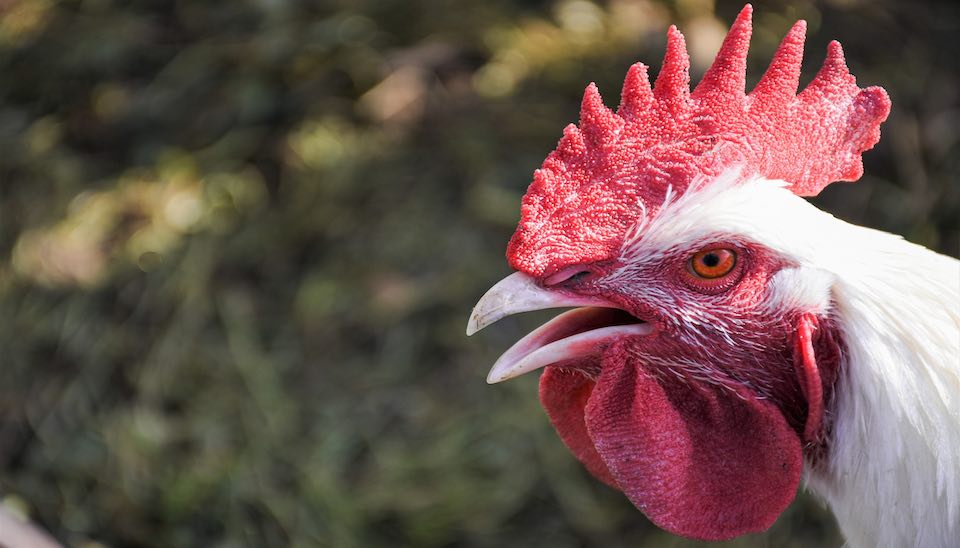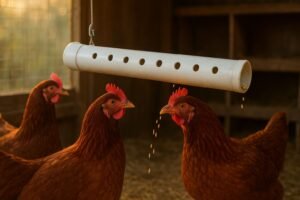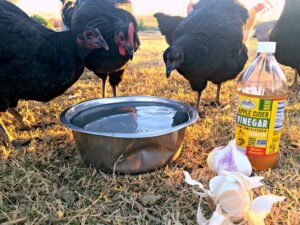The first time I saw my favorite hen, Clementine, panting heavily with her wings held out from her body, my heart sank. I didn’t know what to do. I worried she was on the verge of heatstroke, and I felt completely helpless. This guide is the emergency plan I wish I’d had then.
Heat stress in chickens is a serious and urgent threat. This guide is your emergency action plan. We’ll cover everything from recognizing the signs of heat stress to the best cooling foods and strategies. Crucially, we’ll start with the most important steps: providing water and shade, which are far more critical than food.
First, Know the Danger: Signs of Heat Stress in Chickens
Before you can act, you need to know what you’re looking for. Heat stress can escalate to a life-threatening heat stroke very quickly. Being able to recognize the signs early is your first line of defense, allowing you to intervene before symptoms become severe.
How Do I Tell if My Chickens Are Too Warm?
A chicken’s normal body temperature is around 106°F (41∘C). When that temperature rises, they will show clear signs of distress. Watch for these symptoms, from mild to severe:
- Panting or open-mouth breathing: This is the most common and earliest sign. Chickens don’t sweat, so they rely on panting to release heat, much like a dog. You’ll see their mouths open and their throat muscles moving rapidly.
- Holding wings away from their body: This posture allows air to circulate around their body, providing a small amount of cooling.
- Lethargy and listlessness: Overheated chickens will become inactive and may appear sleepy or unresponsive. They’ll spend their time huddled in shady spots.
- Pale comb and wattles: These body parts are a good indicator of blood flow. When a chicken is too hot, blood is redirected to their core, causing their typically bright red comb and wattles to look pale and shriveled.
- Diarrhea: This is a sign of severe dehydration and electrolyte imbalance. If you notice watery droppings, it’s a clear signal that the chicken’s system is in distress.
- Seizures: This is a sign of advanced heat stroke and an immediate emergency. If a chicken is having a seizure, you need to act immediately.
How Hot is TOO Hot for Chickens?
Generally, chickens are comfortable up to about 80°F (26∘C). Once temperatures exceed 90°F (32∘C), you must take proactive measures to prevent heat stress. It is crucial to remember that humidity makes it worse. High humidity prevents chickens from effectively cooling themselves through panting, making even slightly lower temperatures feel much hotter. Breeds with large combs, like Leghorns, handle heat better than feathered-foot breeds or those with large body mass, like Wyandottes.
Recognizing the early signs of heat stress is the first and most vital step in keeping your flock safe. By understanding these key indicators, you’re empowered to act quickly and effectively, setting the stage for the crucial actions that follow.
Your Immediate Priorities (Before You Worry About Food)
When a chicken is overheating, your first concern must be hydration and shelter, not food. Do not delay these steps. In an emergency, a chicken can go a day without food, but only a few hours without water.
Priority #1: Abundant, Cool Water
A chicken’s water consumption can double or even triple in a heatwave. Dehydration is the primary danger, so you must ensure they have a constant supply of fresh, cool water. Place multiple waterers in shady locations to encourage drinking. Consider using a nipple waterer, as it keeps the water cleaner, or simply placing large, wide-mouthed buckets in the shade. It’s also important to check the water temperature—if it’s warm to the touch, you need to change it out or add ice.
Can I Put Ice Cubes in My Chicken’s Water? Yes, it is one of the best things you can do. The ice will keep the water cool for longer, and the chickens are often intrigued by it, which encourages them to drink more. You can also use frozen plastic water bottles to chill the waterer.
How to Add Electrolytes to Chicken Water Electrolytes are critical for rehydration, as they replenish the minerals (like sodium and potassium) lost when a chicken is panting. You can purchase commercial poultry electrolytes from a farm supply store, which is the easiest option. For a simple DIY solution, you can mix one gallon of cool water with 2 teaspoons of table salt, 2 teaspoons of baking soda, and 1 tablespoon of sugar. This provides a temporary boost for a few hours.
Priority #2: Shade and Ventilation
Always ensure your chickens have a shady spot to escape the direct sun. If you don’t have a natural tree or bush, you can easily create shade by stretching a tarp or shade cloth over their run. Inside the coop, ventilation is non-negotiable. Open all vents and windows, and consider installing a small, battery-operated fan to improve airflow, as long as it is out of the reach of your birds and protected from rain.
Providing abundant cool water and ample shade are your most critical tasks. These two actions alone can mean the difference between life and death for your chickens. Only once these essentials are in place should you focus on what to feed them.
What to Feed Chickens When It’s Hot: The “Cooling Diet”
Once your chickens are safe with water and shade, you can start thinking about food. The goal is to provide foods with a high water content and low carbohydrates.
The Golden Rule: Hydration Over Calories
Digesting food, especially grains, generates internal body heat through a process called metabolic heat. This is why chickens naturally eat less when it’s hot. Your goal is to provide a “cooling diet” that minimizes digestive effort and maximizes hydration. Avoid their regular feed and high-carb treats during the hottest part of the day, as this will only add to their internal body temperature.
The Best Cooling and Hydrating Foods for Chickens
- Watermelon: This is the ultimate heatwave treat. With a 92% water content, it’s a hydrating and tasty snack. Cut it into large chunks for them to peck at.
- Cucumber & Zucchini: Similar to watermelon, these are packed with water and are very easy to digest. You can
chop them into small piecesor hang them from a string for a fun activity. - Frozen Berries & Peas: These are a perfect, fun cooling treat. Place them in a bowl of cool water and watch your chickens “bob” for them. The frozen treats also encourage a bit of foraging.
- Lettuce & Leafy Greens: Crisp lettuce and other leafy greens are high in water and a great source of fiber.
- Tomatoes & Bananas: These are good to offer in moderation. Tomatoes contain lycopene, a natural antioxidant, and bananas are rich in potassium, which helps with electrolyte balance.
What NOT to Feed in a Heatwave
Can You Give Chickens Corn in Summer? You should avoid it. Corn and other scratch grains are high in carbohydrates and require a lot of digestive effort, which creates internal body heat. These are “warming” foods that are excellent for winter but should be skipped on hot days. Other foods to avoid include scratch, oats, and any high-carb scraps like bread.
By focusing on a hydrating, low-calorie diet, you’re helping your flock cool down from the inside out. But food is only part of the solution; next, let’s explore other physical cooling strategies.
Essential Cooling Strategies for 100-Degree Heat
Beyond water and food, there are other simple steps you can take to help your flock.
Can I Spray My Chickens with Water?
Yes, but gently! A fine mist from a spray bottle or a garden hose is a good way to help them cool down without causing stress. Focus on misting their feet and under their wings, where they can release heat more effectively. Avoid drenching them, as this can cause shock and stress.
More Cooling Tricks
- Frozen Water Bottles: Place several frozen plastic water bottles in the coop or run for your chickens to lean against. They will instinctively seek out cool surfaces.
- Shallow Water Pan: Place a shallow pan of cool water in the run. Chickens can release a significant amount of heat through their feet, and standing in a few inches of water will provide instant relief.
- Ceramic Tiles: Place a few ceramic or marble tiles in the coop. These tiles stay cool to the touch and act as a natural cooling pad for the chickens to rest on.
- Create a Mud Bath: Offer a shady, moist patch of dirt. Chickens will use this to cool themselves off and will instinctively create a dust bath.
- DIY Misters: If you have a hose, you can buy a simple mister attachment from a hardware store. Place it in a shady part of the run for a few hours in the afternoon to create a cool, humid environment.
These simple, physical interventions can make a world of difference for your birds, providing them with tangible ways to reduce their body temperature. But if all else fails, you need to be prepared for an emergency.
Emergency Care: How to Treat Heat Stress and Heat Stroke
If you find a severely distressed chicken you need to act immediately. The following steps can be life-saving.
- Immediately
move the birdto a cool, shaded, quiet location. Be gentle to avoid adding to its stress. - Offer cool (not ice-cold) water with electrolytes. Use a syringe or dropper to help them drink, as they may be too weak to do so on their own.
- Dip the chicken’s feet and legs into a bucket of cool water. The feet have a high concentration of blood vessels, making this a quick and effective way to lower their body temperature. Do NOT submerge its body, as this can cause shock.
- Place a cool, damp cloth on its feet and under its wings.
- If the bird does not improve quickly,
call a vet for professional assistance.
Knowing these steps can save a life. But the best care is preventative. The final section offers simple answers to common questions, so you can be prepared for anything.
Heatwave FAQ
Do chickens eat less when it’s hot?
Yes, this is a natural response. A chicken’s body generates heat while digesting food, so they eat less to reduce their body temperature.
What is a warming treat for chickens?
Scratch grains like corn, oats, and wheat are considered warming treats because they are high in carbohydrates and take more energy to digest.
Is it safe to give chickens ice water in summer?
It’s safer to give them cool water with ice cubes in it, rather than pure ice water, to avoid shocking their system.
Do chickens need grit in a heatwave?
Yes, they still need grit for digestion, but because they eat less, they will consume less grit. Continue to offer it free-choice in a separate container.
Can chickens have frozen water bottles?
Yes, placing frozen water bottles in the coop or run is an excellent way to provide a cool surface for them to rest against.
What about baby chicks in a heatwave?
Baby chicks are even more susceptible to heat stress than adults. Ensure their brooder is well-ventilated, keep the heat lamp elevated or turned off if temperatures are high enough, and provide a constant supply of cool water.
How do I prepare for a power outage during a heatwave?
If you rely on fans, be prepared with a battery-powered fan. Have extra frozen water bottles ready, and set up a temporary shady area outside the coop, like a pop-up tent, in case you need to move them.
Conclusion
Being prepared for a heatwave is not just a good idea—it’s a critical part of responsible chicken care. Remember the priorities: recognize the signs of heat stress, provide cool water and shade immediately, offer hydrating foods, and avoid high-carb treats. By being prepared, you can make all the difference in keeping your flock safe and healthy through the summer heat.

Oladepo Babatunde is the founder of ChickenStarter.com. He is a backyard chicken keeper and educator who specializes in helping beginners raise healthy flocks, particularly in warm climates. His expertise comes from years of hands-on experience building coops, treating common chicken ailments, and solving flock management issues. His own happy hens are a testament to his methods, laying 25-30 eggs weekly.



